2018 Hyundai Kona trailer
[x] Cancel search: trailerPage 392 of 523
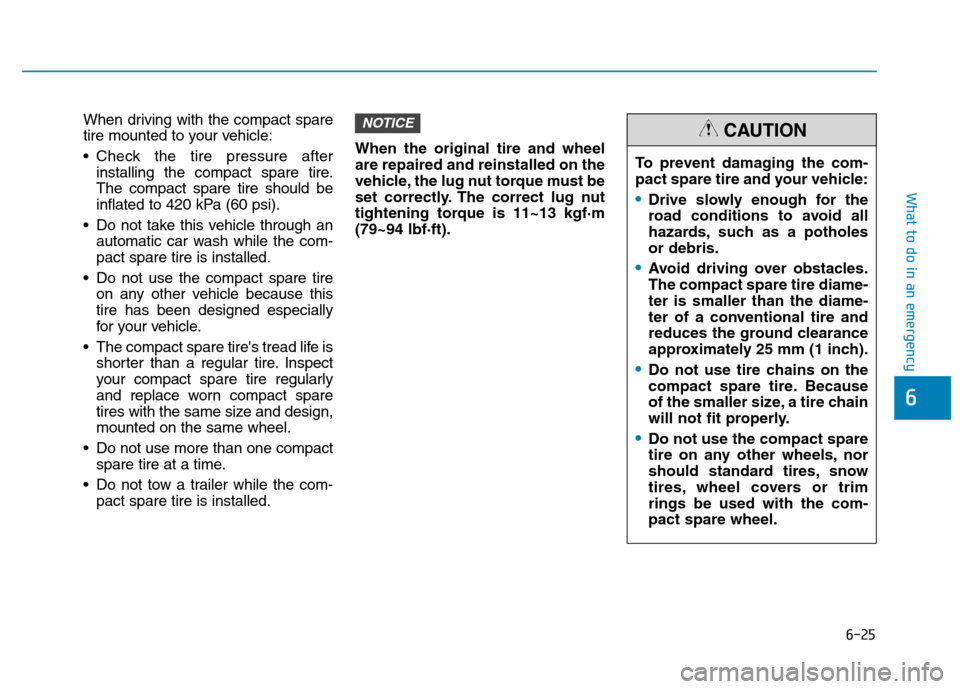
6-25
What to do in an emergency
6
When driving with the compact spare
tire mounted to your vehicle:
Check the tire pressure afterinstalling the compact spare tire. The compact spare tire should be
inflated to 420 kPa (60 psi).
Do not take this vehicle through an automatic car wash while the com-pact spare tire is installed.
Do not use the compact spare tire on any other vehicle because thistire has been designed especially
for your vehicle.
The compact spare tire's tread life is shorter than a regular tire. Inspect
your compact spare tire regularly
and replace worn compact spare
tires with the same size and design,mounted on the same wheel.
Do not use more than one compact spare tire at a time.
Do not tow a trailer while the com- pact spare tire is installed. When the original tire and wheelare repaired and reinstalled on the
vehicle, the lug nut torque must be
set correctly. The correct lug nut
tightening torque is 11~13 kgf·m(79~94 lbf·ft).NOTICE
To prevent damaging the com-
pact spare tire and your vehicle:
Drive slowly enough for the
road conditions to avoid all
hazards, such as a potholesor debris.
Avoid driving over obstacles. The compact spare tire diame-ter is smaller than the diame-
ter of a conventional tire and
reduces the ground clearance
approximately 25 mm (1 inch).
Do not use tire chains on the
compact spare tire. Because
of the smaller size, a tire chain
will not fit properly.
Do not use the compact spare
tire on any other wheels, nor
should standard tires, snow
tires, wheel covers or trimrings be used with the com-pact spare wheel.
CAUTION
Page 395 of 523
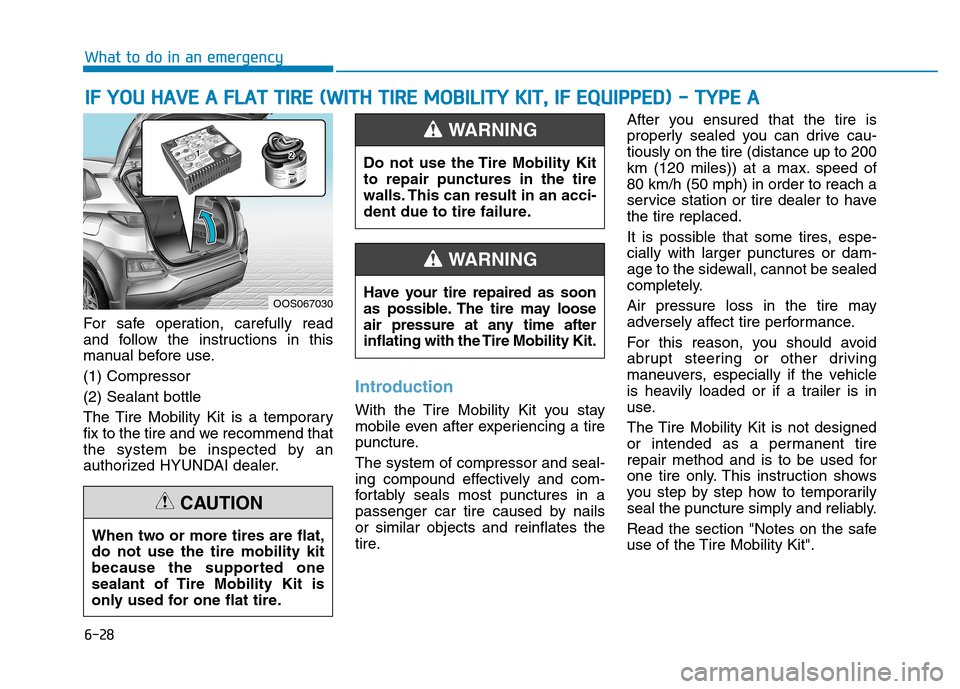
6-28
What to do in an emergency
For safe operation, carefully read
and follow the instructions in this
manual before use. (1) Compressor(2) Sealant bottle
The Tire Mobility Kit is a temporary
fix to the tire and we recommend that
the system be inspected by an
authorized HYUNDAI dealer.
Introduction
With the Tire Mobility Kit you stay
mobile even after experiencing a tire
puncture. The system of compressor and seal-
ing compound effectively and com-
fortably seals most punctures in a
passenger car tire caused by nailsor similar objects and reinflates the
tire.After you ensured that the tire is
properly sealed you can drive cau-tiously on the tire (distance up to 200
km (120 miles)) at a max. speed of80 km/h (50 mph) in order to reach a
service station or tire dealer to havethe tire replaced.
It is possible that some tires, espe- cially with larger punctures or dam-
age to the sidewall, cannot be sealed
completely.
Air pressure loss in the tire may
adversely affect tire performance.
For this reason, you should avoid
abrupt steering or other driving
maneuvers, especially if the vehicle
is heavily loaded or if a trailer is in
use.
The Tire Mobility Kit is not designed
or intended as a permanent tire
repair method and is to be used for
one tire only. This instruction shows
you step by step how to temporarily
seal the puncture simply and reliably.
Read the section "Notes on the safe
use of the Tire Mobility Kit".
II
FF YY OO UU HH AAVVEE AA FF LLAA TT TT IIRR EE (( WW IITT HH TT IIRR EE MM OOBBIILL IITT YY KK IITT ,, IIFF EE QQ UUIIPP PPEEDD )) -- TT YY PPEE AA
Do not use the Tire Mobility Kit to repair punctures in the tire
walls. This can result in an acci-
dent due to tire failure.
WARNING
Have your tire repaired as soon
as possible. The tire may loose
air pressure at any time after
inflating with the Tire Mobility Kit.
WARNING
When two or more tires are flat, do not use the tire mobility kit
because the supported one
sealant of Tire Mobility Kit is
only used for one flat tire.
CAUTION
OOS067030
Page 402 of 523
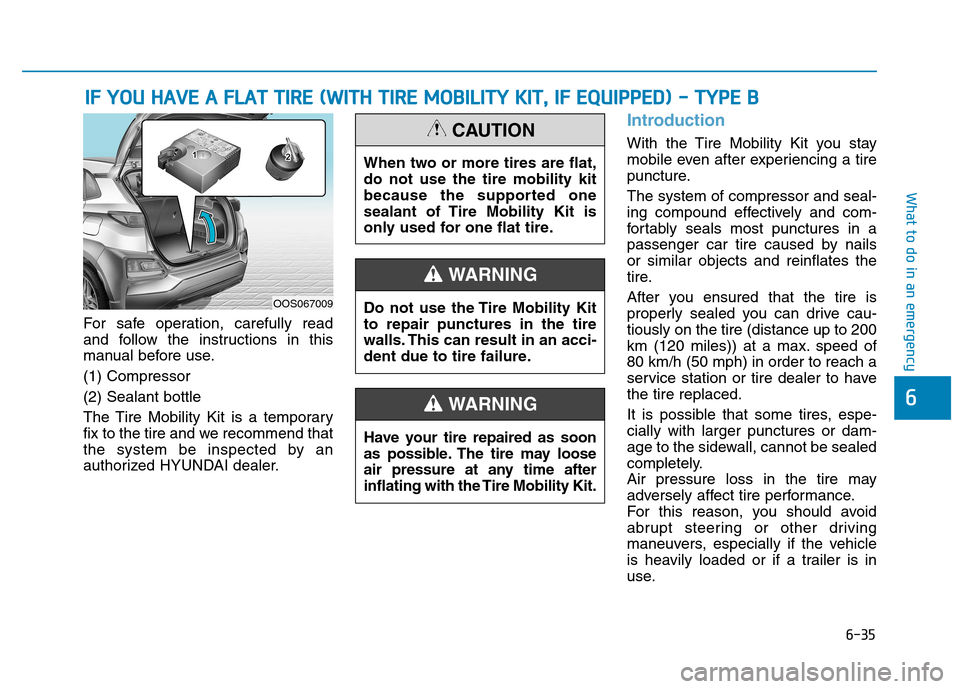
6-35
What to do in an emergency
6
IIFF YY OO UU HH AAVVEE AA FF LLAA TT TT IIRR EE (( WW IITT HH TT IIRR EE MM OOBBIILL IITT YY KK IITT ,, IIFF EE QQ UUIIPP PPEEDD )) -- TT YY PPEE BB
For safe operation, carefully read
and follow the instructions in this
manual before use. (1) Compressor(2) Sealant bottle
The Tire Mobility Kit is a temporary
fix to the tire and we recommend that
the system be inspected by an
authorized HYUNDAI dealer.
Introduction
With the Tire Mobility Kit you stay
mobile even after experiencing a tire
puncture. The system of compressor and seal-
ing compound effectively and com-
fortably seals most punctures in a
passenger car tire caused by nailsor similar objects and reinflates the
tire.
After you ensured that the tire is
properly sealed you can drive cau-tiously on the tire (distance up to 200
km (120 miles)) at a max. speed of80 km/h (50 mph) in order to reach a
service station or tire dealer to havethe tire replaced.
It is possible that some tires, espe- cially with larger punctures or dam-
age to the sidewall, cannot be sealed
completely.
Air pressure loss in the tire may
adversely affect tire performance.
For this reason, you should avoid
abrupt steering or other driving
maneuvers, especially if the vehicle
is heavily loaded or if a trailer is in
use.
Do not use the Tire Mobility Kitto repair punctures in the tire
walls. This can result in an acci-
dent due to tire failure.
WARNING
Have your tire repaired as soon
as possible. The tire may loose
air pressure at any time after
inflating with the Tire Mobility Kit.
WARNING
When two or more tires are flat, do not use the tire mobility kit
because the supported one
sealant of Tire Mobility Kit is
only used for one flat tire.
CAUTION
OOS067009
Page 424 of 523
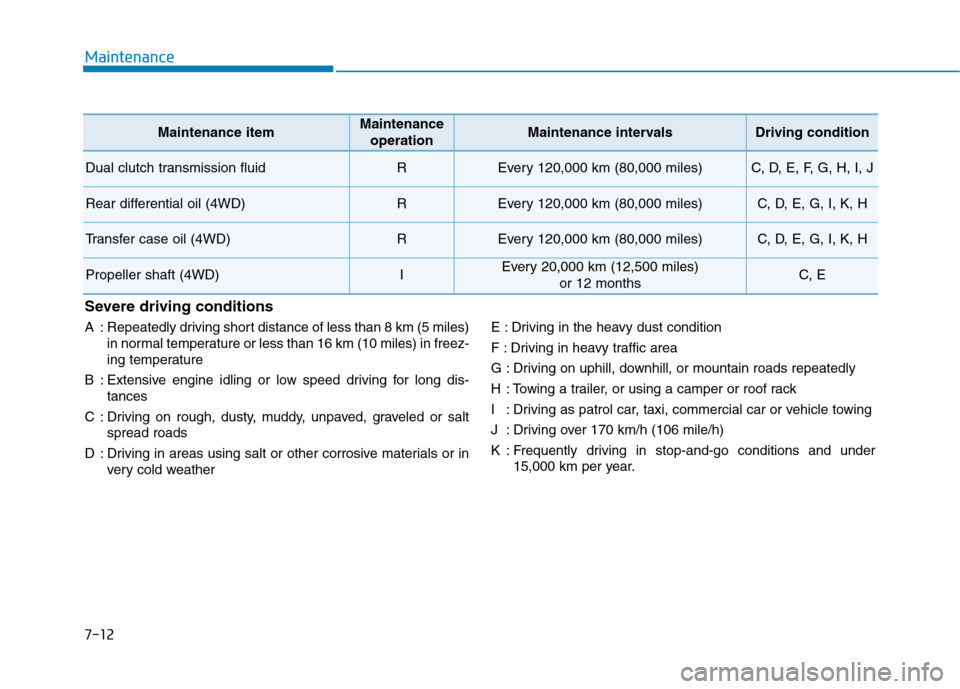
Maintenance
7-12
Severe driving conditions
A : Repeatedly driving short distance of less than 8 km (5 miles)
in normal temperature or less than 16 km (10 miles) in freez-
ing temperature
B : Extensive engine idling or low speed driving for long dis- tances
C : Driving on rough, dusty, muddy, unpaved, graveled or salt spread roads
D : Driving in areas using salt or other corrosive materials or in very cold weather E : Driving in the heavy dust condition
F : Driving in heavy traffic area
G : Driving on uphill, downhill, or mountain roads repeatedly
H : Towing a trailer, or using a camper or roof rack
I : Driving as patrol car, taxi, commercial car or vehicle towing
J : Driving over 170 km/h (106 mile/h)
K : Frequently driving in stop-and-go conditions and under
15,000 km per year.
Maintenance itemMaintenance
operationMaintenance intervalsDriving condition
Dual clutch transmission fluidREvery 120,000 km (80,000 miles)C, D, E, F, G, H, I, J
Rear differential oil (4WD)REvery 120,000 km (80,000 miles)C, D, E, G, I, K, H
Transfer case oil (4WD)REvery 120,000 km (80,000 miles)C, D, E, G, I, K, H
Propeller shaft (4WD)IEvery 20,000 km (12,500 miles) or 12 monthsC, E
Page 430 of 523
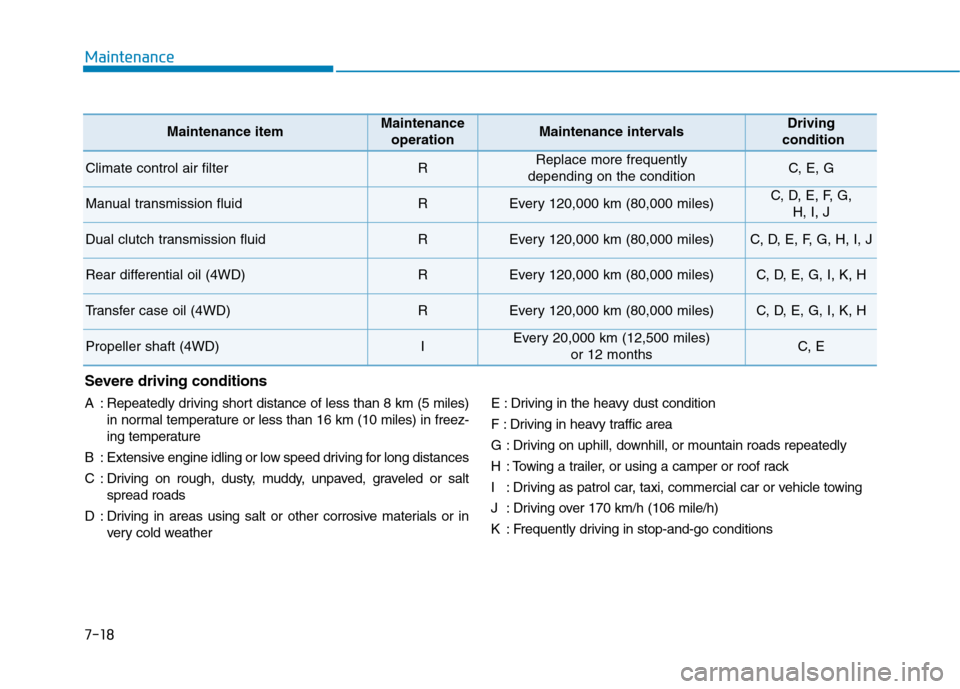
Maintenance
7-18
Maintenance itemMaintenance operationMaintenance intervalsDriving
condition
Climate control air filterRReplace more frequently
depending on the conditionC, E, G
Manual transmission fluidREvery 120,000 km (80,000 miles)C, D, E, F, G, H, I, J
Dual clutch transmission fluidREvery 120,000 km (80,000 miles)C, D, E, F, G, H, I, J
Rear differential oil (4WD)REvery 120,000 km (80,000 miles)C, D, E, G, I, K, H
Transfer case oil (4WD)REvery 120,000 km (80,000 miles)C, D, E, G, I, K, H
Propeller shaft (4WD)IEvery 20,000 km (12,500 miles) or 12 monthsC, E
Severe driving conditions
A : Repeatedly driving short distance of less than 8 km (5 miles)in normal temperature or less than 16 km (10 miles) in freez-
ing temperature
B : Extensive engine idling or low speed driving for long distances
C : Driving on rough, dusty, muddy, unpaved, graveled or salt spread roads
D : Driving in areas using salt or other corrosive materials or in very cold weather E : Driving in the heavy dust condition
F : Driving in heavy traffic area
G : Driving on uphill, downhill, or mountain roads repeatedly
H : Towing a trailer, or using a camper or roof rack
I : Driving as patrol car, taxi, commercial car or vehicle towing
J : Driving over 170 km/h (106 mile/h)
K : Frequently driving in stop-and-go conditions
Page 522 of 523
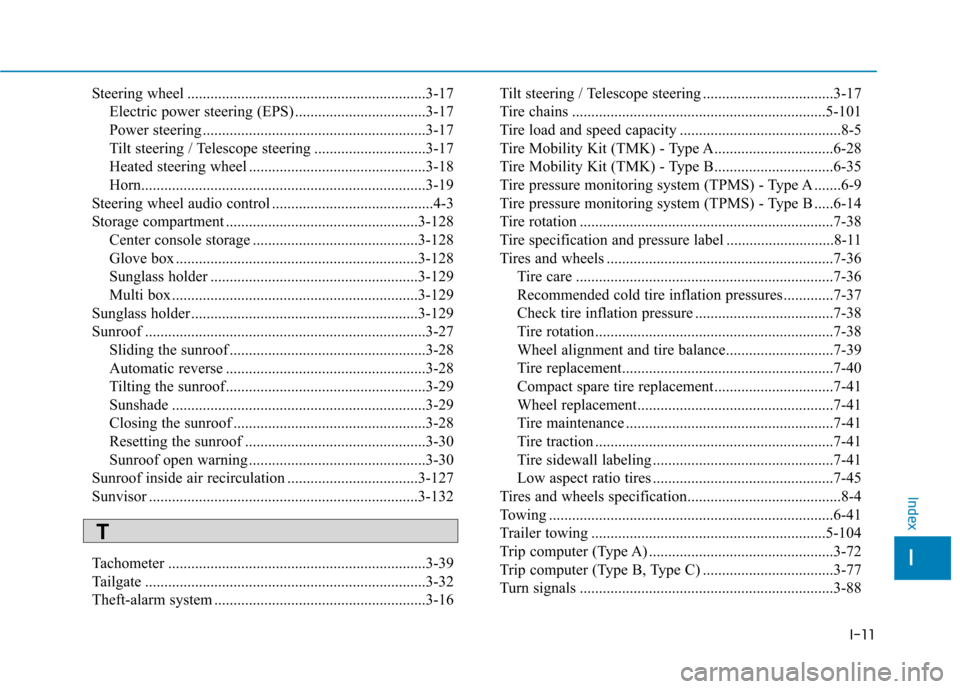
I-11
Steering wheel ..............................................................3-17
Electric power steering (EPS) ..................................3-17
Power steering ..........................................................3-17
Tilt steering / Telescope steering .............................3-17
Heated steering wheel ..............................................3-18
Horn..........................................................................3-19
Steering wheel audio control ..........................................4-3
Storage compartment ..................................................3-128 Center console storage ...........................................3-128
Glove box ...............................................................3-128
Sunglass holder ......................................................3-129
Multi box ................................................................3-129
Sunglass holder ...........................................................3-129
Sunroof .........................................................................3-27 Sliding the sunroof ...................................................3-28
Automatic reverse ....................................................3-28
Tilting the sunroof....................................................3-29
Sunshade ..................................................................3-29
Closing the sunroof ..................................................3-28
Resetting the sunroof ...............................................3-30
Sunroof open warning ..............................................3-30
Sunroof inside air recirculation ..................................3-127
Sunvisor ......................................................................3-132
Tachometer ...................................................................3-39
Tailgate .........................................................................3-32
Theft-alarm system .......................................................3-16 Tilt steering / Telescope steering ..................................3-17
Tire chains ..................................................................5-101
Tire load and speed capacity ..........................................8-5
Tire Mobility Kit (TMK) - Type A...............................6-28
Tire Mobility Kit (TMK) - Type B...............................6-35
Tire pressure monitoring system (TPMS) - Type A .......6-9
Tire pressure monitoring system (TPMS) - Type B .....6-14
Tire rotation ..................................................................7-38
Tire specification and pressure label ............................8-11
Tires and wheels ...........................................................7-36
Tire care ...................................................................7-36
Recommended cold tire inflation pressures.............7-37
Check tire inflation pressure ....................................7-38
Tire rotation..............................................................7-38
Wheel alignment and tire balance............................7-39
Tire replacement.......................................................7-40
Compact spare tire replacement...............................7-41
Wheel replacement...................................................7-41
Tire maintenance ......................................................7-41
Tire traction ..............................................................7-41
Tire sidewall labeling ...............................................7-41
Low aspect ratio tires ...............................................7-45
Tires and wheels specification........................................8-4
Towing ..........................................................................6-41
Trailer towing .............................................................5-104
Trip computer (Type A) ................................................3-72
Trip computer (Type B, Type C) ..................................3-77
Turn signals ..................................................................3-88
I
Index
T